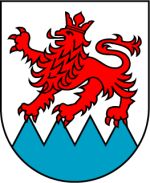Grünwettersbach: Difference between revisions
Knorrepoes (talk | contribs) m (Text replacement - "/Arms of " to "/Arms (crest) of ") |
Knorrepoes (talk | contribs) m (Text replacement - "{{media}}" to " {{de1}} {{media1}}") |
||
| Line 27: | Line 27: | ||
In 1895 the State Archives proposed the above arms instead, based on the oldest arms of the Counts of [[Vaihingen an der Enz|Vaihingen]], lords of the village until the middle of the 14th century. To differentiate the arms from the arms of the Counts is that the field was made silver and the rounded hills in base were made points. The council approved and adopted the design. | In 1895 the State Archives proposed the above arms instead, based on the oldest arms of the Counts of [[Vaihingen an der Enz|Vaihingen]], lords of the village until the middle of the 14th century. To differentiate the arms from the arms of the Counts is that the field was made silver and the rounded hills in base were made points. The council approved and adopted the design. | ||
{{ | |||
{{de1}} | |||
{{media1}} | |||
[[Civic Heraldry Literature - Germany|'''Literature''']]: Die Wappen in Karlsruhe, 1995. | [[Civic Heraldry Literature - Germany|'''Literature''']]: Die Wappen in Karlsruhe, 1995. | ||
Revision as of 11:46, 26 December 2022
This page is part of the German heraldry portal Deutsche Wappensammlung |
Heraldry of the World |
|
German heraldry:
|
Selected collector's items from Germany:
|
GRÜNWETTERSBACH
State : Baden-Württemberg
Urban district (Stadtkreis) : Karlsruhe
Incorporated into : 1972 Wettersbach (1975 Karlsruhe)
| German |
In Silber ein über vier blaue Berge schreitender roter gekrönter Löwe. |
| English | No blazon/translation known. Please click here to send your (heraldic !) blazon or translation |
Origin/meaning
The arms were officially adopted in 1895.
The oldest known seals of the village date from the 14th century. As they are all heavily damaged, it is impossible to determine the design of the field. In the 19th century the village used the arms of the State of Baden with the letters GW on the seal.
In 1895 the State Archives proposed the above arms instead, based on the oldest arms of the Counts of Vaihingen, lords of the village until the middle of the 14th century. To differentiate the arms from the arms of the Counts is that the field was made silver and the rounded hills in base were made points. The council approved and adopted the design.
Literature: Die Wappen in Karlsruhe, 1995.
![]()


